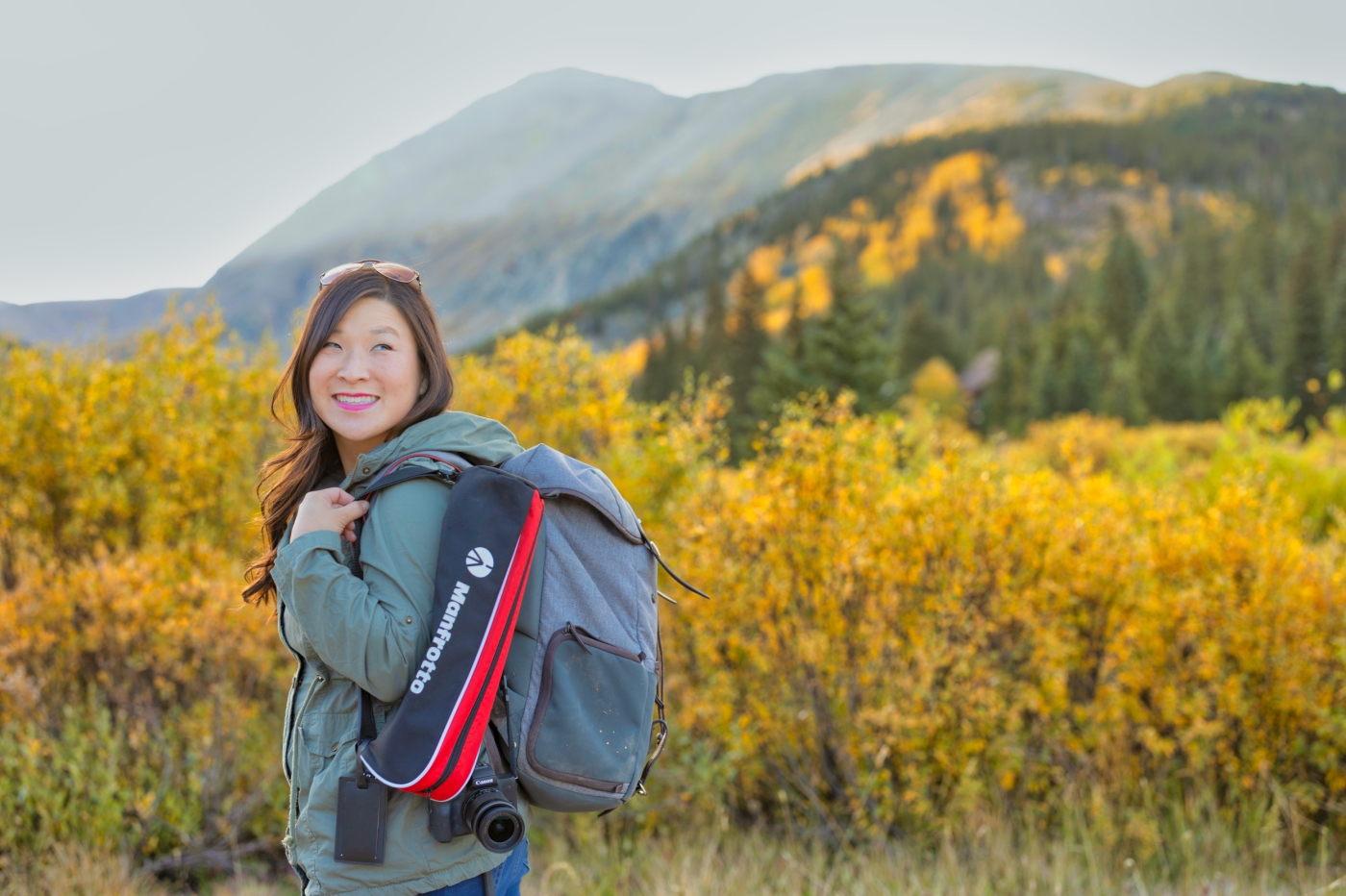The leaves are turning color in Beaver Creek, with little pots of gold lighting up green Aspen groves.
During a morning hike near Day Break Ridge Road, National Geographic photographer Jad Davenport took out his water bottle and splashed a couple of drops on a fallen aspen leaf, a trick of the trade that makes the foliage sparkle before he bent down to get a close-up shot with his iPhone.
Every autumn, Davenport partners with The Ritz-Carlton Bachelor Gulf to lead a fall photography weekend, taking amateur photographers trekking through the golden aspen alleys and into Beaver Creek Village where flower pots burst with color and the bubbling creek make for photogenic vignettes, too.
Peak foliage is here (or just about to be), and capturing Colorful Colorado in all of its autumnal splendor can feel like a monumental challenge as we collectively pull out our camera phones, eager to channel our inner John Fielder. One key, though, to not being overwhelmed and getting a phenomenal set of photos is to curate a theme, Davenport said.
If your storyline is, say, “off-season at a ski resort,” you can focus on stationary gondolas and ski trail signs in your leaf shots, Davenport said. For some movement, snap mountain bikers tearing down the dirt lanes with autumn colors blazing in the background.
“Make the story your own,” Davenport said.
Also, while you may have come to photograph leaves, look for other details to tell your story, he suggested. Maybe that’s a steaming cup of coffee or a trail of Subarus parked on a scenic mountain pass. And to break up your warm-toned color palette, try a close-up of the aspen tree’s white, ultra-textural bark.
The bark has peel marks etched in it from elk. But closer to the ground you’ll notice scarring from rodents, according to Ritz-Carlton Bachelor Gulf naturalist Tyler Reynolds, who joined Davenport and the cohort of amateur photographers on the hike.
“There are hundreds if not thousands of miles of tunnel network created by the rodents that stay active throughout the winter,” he said. “They tunnel to aspen trees to eat the aspen bark, which is one of their main food sources.” But they don’t scurry too far up the tree because they don’t want to be noticed by foxes or coyotes, Reynolds explained.
Wild, right?
Here are more fall foliage tricks from photography experts to help you get some frame-worthy shots in the high country in these coming weeks. But keep in mind this rule that’s as golden as the aspen leaves themselves and will ease the pressure: “Whatever attracts you, trust yourself,” Davenport said. “If you think it’s beautiful, it’s beautiful.”
Get up early or catch the golden hour
For a great fall foliage photo, start around sunrise. That’s when the wildlife is out, Davenport said, and the lighting is superb.
“The best equipment you can have is an alarm clock,” he said.
Also, when it comes to fall photos, you want colors to pop, and the harsh midday sun tends to wash out the colors and make them seem less vibrant, explained Juliana Broste, a Colorado-based travel filmmaker who runs the travel blog TravelingJules.com.
If you’re not an early bird, though, you won’t miss out.
“Golden hour, about an hour before the sun sets, is famous for adding a nice warm glow to the scene, which is very appropriate for the warm feeling of fall,” Broste said.
Play with slow motion mode on your camera
Want fodder for your Instagram reels? Try standing in an Aspen grove on a windy day, put your camera in the slow-motion video mode, and film as the trees shake their leaves loose. If you’re lucky, Davenport said, one will fall right in front of your lens. Sometimes, this takes several attempts, but the payoff is worth it.
You can also rub some chalky aspen bark on your hands and clap to create a cloud, which looks great in slow motion, Davenport said, or toss up some leaves in front of you and let them cascade down.
Keep the sun to your back
The fall colors are going to look best if you are not taking a photo directly into the sun, said real estate and architectural photographer Matthew Digati, a former Glenwood Springs resident who loves photographing the Rockies during the fall.
“When you point your phone into the sun, the colors get washed out and your photo ends up too bright and blurry,” he said. “Instead, find an angle where the sun is behind you. The leaves will look more colorful.”
Mix things up
It’s become second nature to take photos vertically since that’s the direction in which phones’ cameras shoot. But mix things up and get some horizontal shots, too, Digati said.
“When photographing landscapes, many of the best photos will actually need to be taken with your phone horizontal,” he said.
Take a selfie
On a solo hike and want a photo of you with the fall colors? The secret to getting great selfies is to activate the self-timer mode so you have time to strike a pose after you hit the shutter, Broste said. Most cameras have a couple of different options; iPhones have a 3s or 10s self-timer setting, for instance, she pointed out.
But you can take your selfies to the next level by using a remote control so that you can be further than an arm’s length away in your photo. For Canon cameras, the Camera Connect App allows you to preview your shot and control some camera settings from your phone, she said.
“You can adjust your exposure, touch to focus and trigger the shutter,” Broste said. “I also recommend using an intervalometer, which is typically used for time lapses, but you can also use this device to take selfies.”
Having multiple shots means more options to choose from, she pointed out, and some newer cameras have an interval timer setting built in.
Subscribe to our weekly newsletter, In The Know, to get entertainment news sent straight to your inbox.
Join the Conversation
We invite you to use our commenting platform to engage in insightful conversations about issues in our community. We reserve the right at all times to remove any information or materials that are unlawful, threatening, abusive, libelous, defamatory, obscene, vulgar, pornographic, profane, indecent or otherwise objectionable to us, and to disclose any information necessary to satisfy the law, regulation, or government request. We might permanently block any user who abuses these conditions. As of June 15, 2022, comments on DenverPost.com are powered by Viafoura, and you may need to log in again to begin commenting. Read more about our new commenting system here. If you need help or are having issues with your commenting account, please email us at memberservices@denverpost.com.






